Jim McCoy pushes his Hallmark LaVeta to the limit on the challenging off-road trails of Colorado and Utah. Now it’s your turn. Hold on.

Thirty-seven inch tires. Front mounted winch bumper. A shovel, an axe, and a Hi-Lift jack. For professional paramedic and fire fighter Jim McCoy, these are just a few essential tools he chooses for serious off-road truck camping.
Not only is Jim’s story inspiring, but his advice serves to help us better grasp exactly how we need to prepare our rigs, our gear, and ourselves for serious off-road truck camping. It’s time to hit the trail.
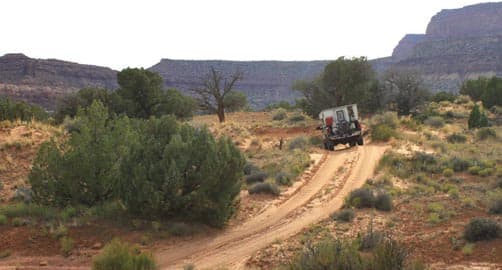
Above: Off-roading to the Dollhouse
TCM: How did you first get into truck camping?
Jim: When I was teenager, my dad had a truck camper and he took us on trips. When I got my driver’s license, I would borrow his truck and camper and take it to local campgrounds with my friends. But, he wouldn’t let me take too far.
I didn’t get my own truck camper until 1994 when I moved to Colorado. I bought an old Mitchell truck camper and used it for a few years. In 1998, I had the opportunity to get a Hallmark LaVeta from a friend who sold it to me for a good bargain. Soon after I upgraded my truck to my current Dodge. The Hallmark is pretty tough and can take a real beating. I take it over extremely rough roads and it handles the overland travel just fine.
The Hallmark LaVeta was originally designed for the Dodge Dakota and similar small trucks. I have made it fit my full-size truck. It’s a nice combination and the best of both worlds. Because of the LaVeta’s small size and low weight, and the truck’s off-road capabilities, I am able to traverse really rough roads, take lots of equipment and gear, and boondock for extended periods of time in comfort.
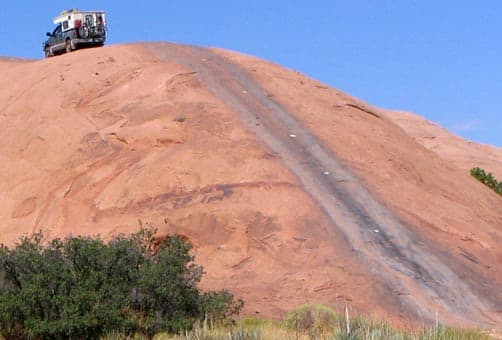
Above: Baby Lions Back, Moab, Utah
TCM: How do you find out about the off-road opportunities and camping spots you enjoy?
Jim: I have three or four subscriptions to off-road magazines. I stare at maps, search online, and type the names trails into Google. I also read other people’s personal trail experiences and stories and got ideas from those as well. It’s just like when you buy a camper. You research it. There are lots of different places to get off-road information.
I like the DeLorme Atlas and Gazetteer maps. They are maps that cover an entire state in an atlas type format. They show highways and roadways like a normal state atlas. They also show recreation roads and forest routes, many of which may require four wheel drive. The maps are also topographical. I highly recommend spending the twenty dollars on the Gazetteer maps. They are fairly detailed and also contain a lot of recreation area information. Another company called Benchmark Maps, also makes state atlases that are detailed and topographical, and show recreation and forest routes. I like those too. The two maps are a great combination together and will give you a great feel for the terrain and area you are going to explore.
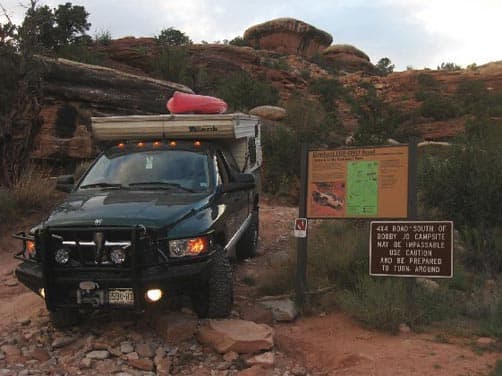
Above: Elephant Hill trail
Most forest service roads are used by forest service vehicles, and are not too terrible. But some of them do range from moderately difficult to extremely challenging. Many of the easier routes have improved campgrounds. Most of the hard trails allow dispersed camping or boondocking, or may even have designated backcountry off road campsites, but always check local regulations and rules. Many of the national parks in Colorado and Utah have off-road trails within the parks that range from easy to difficult. The park service people are a great resource.
I left the east coast to come out here to Colorado for the four wheeling and wealth of all the recreational opportunities. It’s all about the lifestyle.
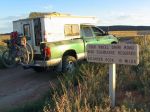 |
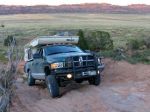 |
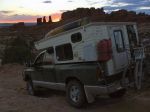 |
TCM: What’s been your favorite off-road experience?
Jim: There are endless possibilities of where you can go and what you can do in the BLM lands, national forests, and parks. My favorite experiences have been in Utah, Colorado, and parts of Nevada.
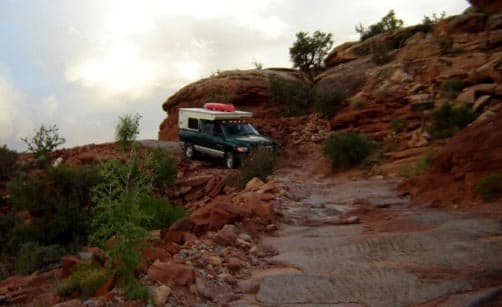
Above: Descending the last segment of Elephant Hill
Elephant Hill through the Needles District of Canyonlands allows for some pretty rough and remote off-roading. I need to start breaking out and seeing other areas and states. I love exploring.
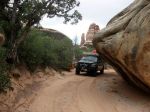 |
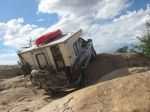 |
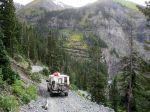 |
TCM: What kind of training or practice do you recommend before someone takes their truck camper off-road?
Jim: My training has been a culmination of over thirty years of recreational four wheeling with Jeeps and trucks on many types of trails and surfaces, from the barrier beaches of Long Island and the east coast, to the mountains and canyons of the Rocky Mountains, through Utah, and the desert Southwest.
My experience has helped me to learn a broad range of off-road skills. I was among a group chosen by my career fire department a couple years ago to attend an off-road recovery class by professional instructor Bill Burke. After the class, another off road experienced firefighter and I helped instruct the rest of the department in basic off-road driving and recovery skills with our wildfire four wheel drive trucks.
Although I feel I know quite a bit, there is always more to learn. Last Spring I put myself through a few more classes on recovery and other basics at the Overland Expo. I believe that my years of practical experience, trial and error, breaking a few things, combined with my continued interest in professional instruction and classes, will help to give more credence to my off-road opinions and advice.
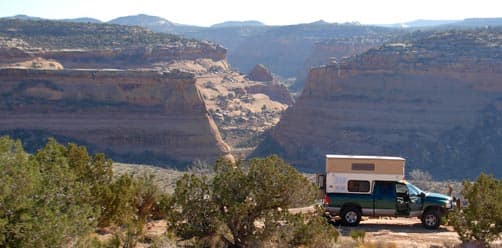
Above: Jim’s Hallmark La Veta in Rabbit Valley
TCM: Do you recommend the classes at the Overland Expo to someone who is interested in improving their off-road skills?
Jim: Yes. Bill Burke and the Overland Expo are two that I’ve experienced and can recommend. The Overland Expo gives a great overview of overland travel skills and techniques. It has great stuff for beginners up to the experienced. They also have some great hands-on classes at the Expo, usually in one to two hour time blocks. You see lots of new innovations and products, and get to meet a lot of the who’s who in the overland industry. It’s well worth it. I’m hoping to go again this year for the second time.
Bill Burke is a more of a personal trainer, and I believe he works with individuals as well as groups. Bill offers detailed, in depth, hands on training from a few hours to a few days. I personally learned a bunch from both Bill and the Overland Expo classes.
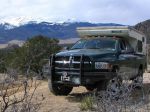 |
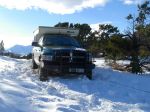 |
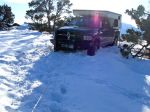 |
Above: Jim using his winch on Buena Vista trail
TCM: How do you know whether or not you can make it through a trail ahead of time?
Jim: I make a decision based on my past experience, knowledge of my truck’s abilities and limitations, plus my skill set for off-roading in general. I personally may attempt more, or less, than others out there, based on my own levels of experience.
There may be obstacles on a certain trail that the truck camper won’t negotiate on its own. But, I may be able to winch, or build up the trail in a small spot by hand to get through. I just have to make a determination of, “is my current objective worth that effort, and what are the likely consequences of a failed attempt?”.
Sometimes I have parked at a particular juncture and walked a mile or two of trail to see what lies ahead. Early this fall, I did a four mile walk ahead on a tough trail to get out of Sinbad Valley on the Colorado-Utah border. The whole way I’m saying to myself, “rough trail, but very doable”. When I got to the end there was a locked gate for private property that maps did not indicate. I was glad I walked it first despite the distance.
Also, there have been some hard trails that I have pre-driven in my Jeep, and thought that someday I’d like to return with more gear and the big truck for an extended stay. That was the case with Beef Basin and the Needles District of Canyonlands.
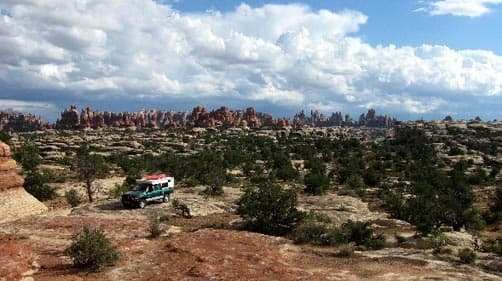
Above: In the heart of The Needles, Canyonlands, Utah
As we discussed, my camper is small and fairly light on a heavy duty truck. I do have to take into account for a higher center of gravity, but not too much because of the smaller camper dimensions and lighter weight. My Hallmark LaVeta has proven to be a strong camper with all the twisting and bouncing it sees.
TCM: Walking the trail ahead to see what obstacles await is excellent advice. What else would you recommend for newbies interested in off-road truck camping?
Jim: If you don’t have some good practical off road experience, and know your truck’s abilities with and without a camper, don’t undertake a major trip alone.
If you are new to off-roading, and want to combine it with truck camping, check out the Overland Expo and Bill Burke websites to learn more about off-roading and off road camping. Internet resources are almost endless. A local 4×4 club may help too.
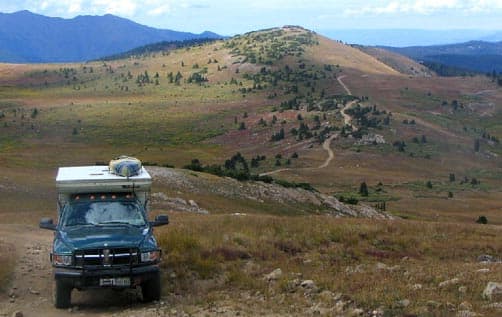
Above: Taylor Pass
Only do what you are confident you and your rig can do and always have a plan B! Travel with people who are experienced if you are not. Challenge yourself and your rig in small increments, working up the scale. If you can, practice where you’re not pressured near home before you commit to a trip. Local practice is a great excuse to go out and play on any given weekend.
If you can, use out of the vehicle spotters on any big challenge. The spotter, or outside driver, is the boss. Use someone you trust, and obey their commands. If you are solo, get out and walk anything you are traversing that you can’t obtain a visual on or is questionable. Driving into a mine shaft, deep ditch, or off a cliff can be a costly and even deadly mistake. It’s better to walk a few yards now, then ten miles for help or be stranded.
If you know where you’re going, there is probably a report or opinion, with stories and pictures somewhere online for any given trail.
Like Warn says, “Go Prepared”. A good topographic map of your target area, and supplies for an unplanned night or three, are good measures among all the other off-road gear you should have.
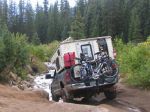 |
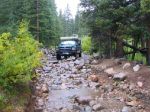 |
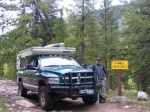 |
At a minimum have a spare vehicle key, fuses, Hi-Lift Jack, shovel, recovery strap (loops only, no braided or sewn in hooks), tire plug kit, means to air up a tire, a real spare tire, duct tape, first aid kit, water (for drinking or refilling a radiator), lug wrench (don’t laugh), selection of tools for minor repairs specific to your vehicle, good flashlight, and an ABC rated fire extinguisher.
I also have in both of my four-wheel drive vehicles an extra upper and lower radiator hose, a serpentine belt, and universal joint specific to each vehicle. This is not all inclusive, it just touches the start of the list. You can Google what other folks are doing and recommending.
It’s very helpful to have some mechanical skills to be able to do a minor trail repair, think outside the box, and trouble shoot. That can be the difference between a good off-road experience and a long walk out or being stranded.
I’ve had my share of simple things happen that I’ve had friends tell me would have stranded them. Two examples that come to mind were a severed metal brake line, and losing a front brake caliper bolt causing the caliper to bind into the rim. Both were trail repaired with hand tools and logic in less than thirty minutes. The repairs got me off the trail and to the nearest town for a permanent repair. I know there’s stuff that could eventually stump me.
TCM: Those mechanical problems would have stranded us too. Are there ratings out there so you know the difficulty of a trail ahead of time?
Jim: I ask the rangers about the difficulty of the trails if I am in a state or national park. The park service usually has easy, moderate, or difficult ratings. On some four wheeling websites, you may see a one to five rating, one being easy, up to five being an extreme rock crawling situation. They also talk about what kind of vehicle to use for a given trail.
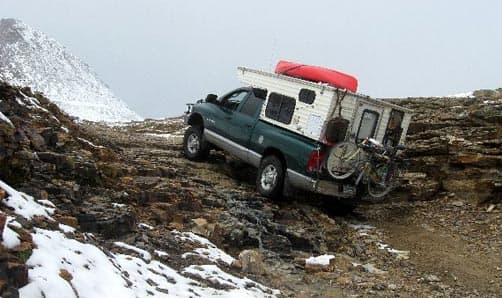
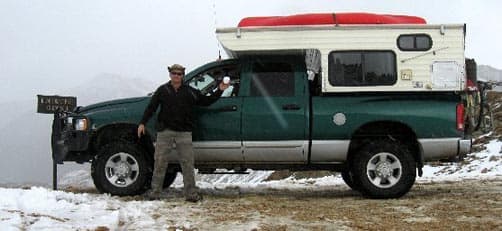
Above: Jim at Black Bear Pass
TCM: What have been some of the trail obstacles that you have encountered?
Jim: Besides really steep or loose hills, the most challenging off-road obstacles for the truck camper are when the rig leans heavily to one side or the other. That can be a challenge because of the weight distribution with the loaded camper. You have to think about if the camper water tank is full and how high up your heavy gear is in the camper. Packing becomes a situation where you need to make sure your heavy stuff is as near the camper floor as possible.
Again, walk the trail before you drive it, and don’t just put it in four low and hope you can get through it. Look at where your tires will be traveling. If there’s a hole that’s too deep, put some rocks in it. Truck campers are not jeeps and are not going to crawl over some obstacles as easily.
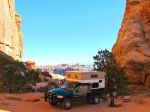 |
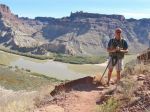 |
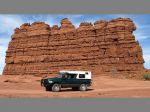 |
Above: The Dollhouse, Utah
TCM: What safety precautions do you take being that far away from civilization?
Jim: I’m in public service as a paramedic and firefighter. In my truck camper, I carry an extensive first aid kit and I encourage anyone going in the back country to do the same.
There’s no cell in many remote places such as the Doll House, so there may be no immediate way to contact people. A ranger may come by every few days, but it depends where you are, it may be totally remote and not patrolled.
I carry a SPOT satellite transmitter. Even with cell signal or SPOT, help can still be hours away. I have sent hundreds of okay signals on my SPOT and rechecked them after my trips, so I’m confident that it’s dead on. If I do have a life threatening situation, as long as I’m not in a satellite shadow, I’m confident I can get my message out.
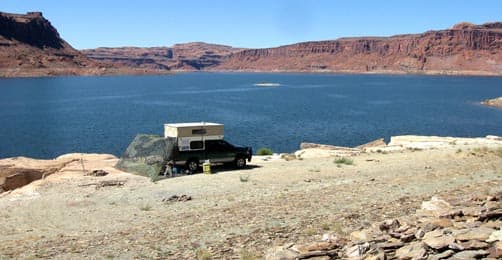
Above: Blue Notch Bay, Lake Powell. Ten miles of mild off-roading to get there.
TCM: We have a SPOT and use it mainly to track where we’ve been and to tell our families that we’re okay and on the move. Do you use a GPS on the trails?
Jim: Yes I do. I have a Garmin GPS with topographic maps. I also carry GMRS radios, like the “Motorola Talkabouts”. I have a five watt model. A lot of times when I’m hiking I will turn it on and carry it with me. I put it on scan and listen for other people’s transmissions. I make a mental note of what channel people are on. GMRS radios are fairly inexpensive.
I also have a UHF, Ultra-High Frequency, radio from my volunteer fire department. It has two Ham radio channels. I often go to remote places and know there’s always the possibility some kind of emergency could happen.
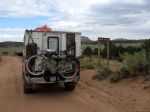 |
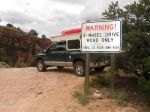 |
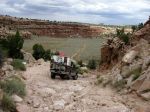 |
TCM: Do you bring extra fuel with you?
Jim: I take extra fuel on some trips. Most of the time I don’t because I have a 350 mile range with the truck. But you never know, you may run into someone else who’s out of fuel. If you want to spend a lot of time exploring a particular area, you may need extra fuel.
I almost always bring my mountain bike. That’s like the escape pod. If I flip my truck or have a breakdown I couldn’t repair, I can get on my mountain bike and put on a lot of miles if I need to. It’s a way out without having to walk. That’s almost always with me, unless I’m going somewhere in the snow where I can’t use it anyway. I’m an avid mountain biker, so for me it’s almost like having a back up vehicle.
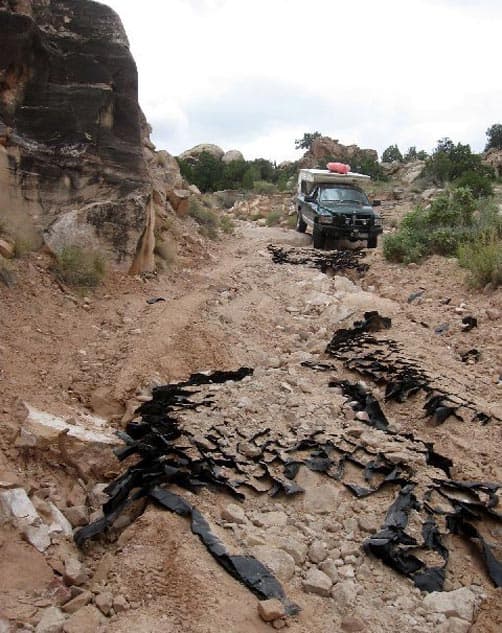
Above: Heading into the heart of The Needles, Canyonlands, Utah
TCM: I know our readers will really appreciate your insights and advice on off-road truck camping. Is there anything else about off-roading or truck camping that you would like to share?
Jim: Go prepared. Have a plan, and a back up plan. If you have a solid itinerary or even a good general idea of where you’re going and for how long, leave that information with someone who could give it to authorities if that situation should arise.
In any unexpected situation, and I know it can be easier said than done, but it’s very true and essential to remain calm! Bring extra gear, tools, and basic parts. Be prepared for being in the middle of nowhere in an unplanned extended stay. The truck camper can make that situation more tolerable. And when it’s a planned extended stay in the middle of nowhere (those are the best), truck campers help you get lots of gear and supplies out there with you, along with all the creature comforts your particular camper offers. Get out there!
TCM: Thanks Jim. I hope we can be as daring and adventurous off-road as you are some day. We may bring you with us.
Jim: You’re welcome. That would be fun.
| JIM MCCOY’S TRUCK CAMPER RIG |
| Truck: 2003 Dodge Ram 2500, quad cab, short bed, single rear wheel, 4×4, diesel |
| Camper: 1990 Hallmark LaVeta |
| Tie-downs and Turnbuckles: Generic steel chains, bed mounted |
| Suspension Enhancements: Firestone Airbags, Rear: stock springs, 1.75 inch rear shackles by Thuren, Rancho 9000 shocks, Front: KORE variable rate 3 inch springs in the front, Bilstein 5100 shocks to match that set-up |
| Gear: 37 inch tires, winch bumper in the front, back of truck rack that has shovel, ax, pick matix maddox, high lift jack and extra fuel can |
